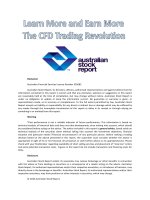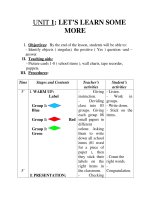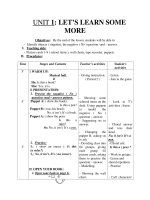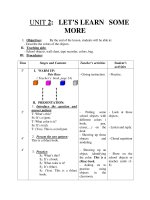Learn more study less
Bạn đang xem bản rút gọn của tài liệu. Xem và tải ngay bản đầy đủ của tài liệu tại đây (2.02 MB, 228 trang )
“If you understand something in only one way, then you don't really
understand it at all. The secret of what anything means to us depends on
how we've connected it to all other things we know. Well-connected
representations let you turn ideas around in your mind, to envision things
from many perspectives until you find one that works for you. And that's
what we mean by thinking!”
-Marvin Minsky
Copyright 2008, Scott Young
All Rights Reserved
Table of Contents
Introduction
7
Part I: The Holistic Learning Strategy
17
My Story
How to Use This Book
Constructs
Models
Highways
The Sequence of Holistic Learning
Acquire
Understand
Explore
Debug
Apply
Test
Pinpointing Your Weaknesses in the Sequence
37
Information Structures
70
Why Your Classes Are Boring
Goals for Learning
87
89
Arbitrary
Opinion
Process
Concrete
Abstract
How to Use the Five Categories
Part II: Holistic Learning Techniques
92
Acquiring Information
96
Linking Ideas
114
Speed Reading
Active Reading
Flow-Based Notetaking
Metaphor
Visceralization
Diagraming
Concept Diagrams
Flow Diagrams
Image Diagrams
Handling the Arbitrary
141
Extending Ideas
169
Review of Holistic Learning Techniques
183
The Link Method
Steps for Using the Link Method
Challenges With the Link Method
The Peg Method
Information Compression
Mnemonics
Picture Linking
Notes Compression
Practical Usage
Model Debugging
Project-Based Learning
Part III: Beyond Holistic Learning
The Productive Student
Manage Your Energy
Don't “Study”
Nuke Procrastination
Batching
Be Organized
185
186
Educate Yourself
202
Structuring Learning Habits
Overcoming the Frustration Barrier
Setting Learning Goals
Summary & Self-Education Resources
Part IV: Summary & Quick Guide
214
Getting Started
Starting a Mind Challenge
Set Up a Better Study Routine
Productivity Resources
Recap of Major Concepts
Special Thanks
About the Author
228
229
Introduction
What makes somebody smart?
Is it raw brainpower? Accumulated knowledge? Is it just academic learning or
does it also include your experiences, people skills and intuition?
Intelligence is difficult to define. Although IQ tests and various exams try to
measure it, deciding what makes somebody smart is hard to do. I prefer to avoid
universal definitions and focus on a more practical one:
Being smart means being able to learn quickly, remember a large amount of
information and be able to sort that information in a way that achieves your goals.
This is a much more personal definition. Learning goals can differ from person to
person. You might just want to get A’s in all your courses. John might want to
become a master at computer programming. Susan might want to retain more from
7
the books she reads in her spare time. Another person might want to be able to apply
concepts to business situations.
It’s up to you to decide what being smart means.
This book isn’t about reaching an arbitrary definition of intelligence. Rather, it’s
about giving you a strategy for learning. From this strategy, called holistic learning, I’ll
provide a set of different tools to put that theory into practice.
Some of these tools won’t fit your learning style or goals. That’s fine. My hopes is
to provide a large assortment of tools that, with the backing of the holistic learning
strategy, you can use to tailor your own approach. With practice many of these
techniques can become powerful weapons in your learning arsenal.
This book has two major goals. First, the holistic learning strategy should give you
a model for how to learn better. Without an easily understandable theory of learning, it
is difficult to make improvements. By seeing the holistic learning strategy you have a
basis for identifying your weaknesses and improving the way you learn.
The second objective of this book is to provide a variety of learning techniques.
Throughout the book I’ll explain what these techniques are and how they fit within the
holistic learning strategy. Included with this book are exercise printouts so you can
8
practice these methods.
I wish you the best of luck in all your learning efforts and hope you enjoy the book.
It took a great deal of effort, tweaking and experimentation to write. Hopefully that
effort has been well invested and you can improve the way you think.
9
My Story
I’ve always been able to learn quickly. Getting A’s and A+’s with little studying
before tests wasn’t a challenge for me throughout school. While in University, I’ve
maintained an average that sits between A and A+. Despite this, I don’t spend more
than the average person on homework. In fact, I might even spend less.
Once, I wrote an inter-provincial test (I’m Canadian) for chemistry. The only
problem: I didn’t know I was supposed to write the test until a pencil and bubble sheet
were sitting in front of me. On top of this, the test was on material I wasn’t familiar
with and topics that were never covered in my class. I was given an hour and a half to
write the exam. I left after forty minutes because I wanted to eat lunch.
I won first place and received a check for $400.
Self-learning has also occupied my time. I’ve taught myself several programming
languages, business and writing skills and my bookshelf has hundreds of books I’ve read
10
in just the past two years. I’ve also dabbled in graphic design, musical composition and
anything I could get my hands on.
Learning has always come easily to me.
Up until this point, I’d just be another smart kid. “Gifted” might fit as well,
although there are people whose mental feats would put my small achievements to
shame. I’d be just another kid who got a more favorable genetic cocktail, had pushy
parents or some sort of glandular accident.
And if you read this far, you could probably slap on arrogant and boastful.
Until recently I probably would have agreed with you. But then something strange
happened. I began to notice something different about myself and people even smarter
than me. It wasn’t just that smart people learned better or faster.
They learned differently.
Smarts requires a different strategy. Smart people had picked up different tactics,
11
sometimes intentionally but usually completely without awareness of them. It was
these different strategies that made the difference in understanding.
That different strategy I called holistic learning. I call it holistic learning because it
challenges you to view learning as a comprehensive whole, instead of a list of
memorized facts. Smart people tend to make fewer distinctions between branches of
knowledge and can easily relate one set of understandings to another.
By learning holistically, smart people are able to quickly integrate new
information. More importantly, this information sticks. They actually “get” the
concepts and see how the concepts relate to far more than just the problems given.
Once I was told a story that demonstrates this point perfectly:
Once upon a time, a student was in a physics class. He had achieved an otherwise
perfect score, but the marker had graded him poorly on one question. The question had
asked him how he would measure the height of a building using a barometer.
The student had written down, “Go to the top of the building. Drop the barometer
and count the seconds until it smashes on the sidewalk below. Then use the formula for
12
acceleration by gravity to determine the height of the
building.”
Of course, having referenced a barometer, the
tester expected the student to use air pressure as a tool
for measuring height. Since this answer did not
demonstrate that the student knew how to solve
questions about air pressure, he couldn’t pass that
portion of the test.
When the student brought up that his answer did solve the question being asked,
the professor made a compromise. He said that he would let the student answer the
question again with a different method. And if the student solved the problem again, he
would award him the marks for the question.
Immediately the student responded that he would use the barometer to bang on
the door of the landlord in the building. When the landlord answered the door, he
would ask, “How tall is this building?”
At once, the professor saw what the student was doing. He asked him if he knew
of any other methods to reach the answer. The student said that he did.
13
He recommended tying a long string to the barometer and measuring the length of the
string. Or swinging the string as a pendulum and inferring the height by the motion it
created.
The professor decided to award the student the marks. As the story goes, the
student was a young Niels Bohr, later becoming the famous physicist and discovering
the nature of electrons inside atoms.
This student didn’t just know how to get the answer. He also understood the entire
scope for which the problem existed. Instead of seeing the problem in the same terms
he had been taught, he could easily view it a number of ways.
The goal of holistic learning is to replicate this process with the information you
want to learn.
14
How to Use This Book
This book isn’t designed to be read once, instantly making you a superior learner.
Instead, think of it as a handbook. While the broader concepts of holistic learning
might be understood the in the first reading, all techniques require practice. Expecting
to master these techniques immediately is like trying to hit a bulls-eye with an arrow,
when you’ve never held a bow before.
That is why, I've included with this book supplemental exercises and printouts.
They can provide starting points the types of learning challenges these techniques are
meant to solve.
Initially adopting these techniques may slow your learning down. Any transition
to a new method will have an adjustment period. But once you become comfortable
with these techniques you can learn more effectively without wasting as much time
trying to relearn material you didn’t understand the first time.
These techniques can’t rest just within an academic setting. Holistic learning needs
to encompass anything you want to understand. The more broadly you can apply these
15
methods, the better they function as a tool for increasing your understanding.
So the next time you pick up a book, attend a class or learn something new, think
about the strategy of holistic learning. Ask yourself how you can apply it and what
techniques you want to use. As the techniques become habits, it will be easier to
permanently integrate any new idea.
Quick Tip!
Holistic learning introduces many new concepts and techniques.
You'll get the best results if you focus on learning only one skill at a time.
Throughout the second half of the book, you will see Mind Challenges.
These challenges are set up specifically to help you adopt these new
learning methods.
16
◦ Part I ◦
The Holistic
Learning Strategy
What is Holistic Learning?
Holistic learning is the opposite of rote memorization.
Rote memorization involves repeating information enough times with the hopes
that it will stick. Trying to remember a physics formula by repeating it to yourself
dozens of times is learning by rote. This also a poor way to learn.
If you read the story about the student from the last section, you can probably see
that smart people don't learn by rote. Do you think Niels Borh, as a young physics
student, had formulas memorized in his head? Coming up with so many unique ways to
solve a physics problem, it was the opposite. He understood what every symbol in the
formula meant, and knew why it was there. He knew the rules so he knew how to
break them.
Holistic learning is a theory for learning that more accurately describes how your
brain works. Your brain isn’t the same as a computer filing system. Computer files are
stored in strips of 1's and 0's in locations on a hard drive. Your brain stores information
18
as associations between billions of neurons.
Rote memorization might work if we had computer
brains. All it would take is an accurate copy of
information and you could memorize anything.
Unfortunately, we don’t have computer brains and that
is why rote memorization is a less effective way to
learn.
Holistic learning takes a different approach.
Instead of trying to memorize information by making a
perfect copy in your brain, it uses the web of neurons you have. Holistic learning
creates webs of information. One idea relates to another idea. That interrelating of
ideas allows you to easily navigate through complete understandings.
With holistic learning, ideas aren’t learned in isolation. If you follow holistic
learning closely enough, you’ll soon realize that it is impossible to learn an idea in
isolation. Learning anything requires associations. The more associations you can
create and the stronger those associations are, the better.
Rote memorization would suggest learning fits into neat little boxes. A box for
math containing algebra, arithmetic and calculus. Your calculus box contains more
19
boxes for how to find the derivative of a function, and a few common applications of
those rules. Nowhere does your calculus box contain information on biology, history or
the plot of a science fiction movie.
But learning doesn’t fit into boxes. Learning fits into webs.
A holistic learner wouldn’t take such an organized approach to storing information
(which might explain why so many smart people have horrible organization skills).
Instead holistic learners connect everything. A derivative isn’t just a formula, it’s a
feeling, an image and you can relate it to flying a supersonic jet.
Rote memorization seems to make sense
when you can’t see the alternative. When you
don’t know the steps learning should follow
and lack techniques to move through those
steps, simply pounding information in your
skull seems to work. This is like a caveman
using a rock to hunt mammoths instead of a
rifle. Until you understand the steps and
techniques for learning, rote memorization is
20
crude and inefficient, but it still works better than nothing.
How You Store Information
Holistic learning is my hypothesis for how learning actually works. I say
hypothesis because holistic learning is less scientific fact and more practical metaphor.
Science still has a long way to go to discover the physical connections in the mind.
Holistic learning simply suggests one way of viewing how smart people manage to learn.
Whether electrons actually exist as billiard balls or violin strings jumping around a
cloud of protons is less important than the implications of these metaphors. Holistic
learning, similarly, is about providing an easily accessible theory that seems to fit how
information is stored, rather than a description of the biological processes buried in your
mind.
Holistic learning is based on three main ideas:
1) Constructs
2) Models
3) Highways
21
As I’ll explain, seeing how these three elements fit together makes applying the
holistic learning strategy easier. Just as knowing the different chess plays is useless
without knowing that a bishop moves diagonally, knowing the holistic learning strategy
is useless unless we both operate from the same points of reference.
Quick Tip!
Holistic learning is based on linking ideas as a way of remembering
and applying them. The best techniques to start learning are metaphor,
visceralization, flow-based notetaking and diagraming. These methods
form the foundation of holistic learning.
22
23
Constructs
A construct defines a set of tightly interlinked understandings. For example, if
you’ve tried your hand at learning to create programs with C++, you probably have a
C++ construct. This construct defines all your knowledge about C++ and is the sum
total of all the interconnected ideas about C++.
Think of a construct as being like a city in your mind. Within a city you have
thousands of buildings you can travel between. Some are big and important and are
linked by roads to hundreds of other buildings in your city. Others are less important
and only have a few dirt paths leading to them.
In the landscape of your knowledge, your mind is full of these cities. Your basic
math and language skills are probably large, efficient cities. You have no problem
navigating from 3+4-10 to 10*3+7. These questions are easy because your constructs for
basic math are highly developed.
Understanding is the result of a highly developed construct.
Are there certain subjects you just “get”? These subjects are easy for you to
understand and seem obvious. Chances are this is because those subjects lie within
24
highly developed constructs. They are like cities where the roads are clean and free of
traffic congestions. The buildings are maintained and rarely are entire pathways
blocked off.
In contrast, are there certain subjects you have difficulty understanding. These
would be like newly constructed or poorly designed cities. The roads don’t lead to
many places. It is easy to get lost and there are many buildings which need to exist but
either haven’t been built yet or have been lost in the maze of roads and wrong
directions.
Ask yourself this question: In a city which building would be the easiest to locate?
A) One that is connected to many other buildings through hundreds of roads, or
B) One that has a single dirt path connecting it to only one other building.
The building in A would be much easier to find. If you got going down the wrong
path, you wouldn’t have much trouble eventually reaching your destination. With the
situation in B, you are relying on chance that you stumble upon the only building that
connects with your final location.
25









